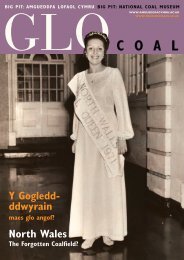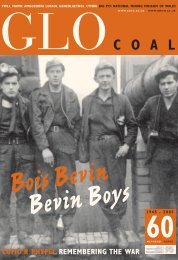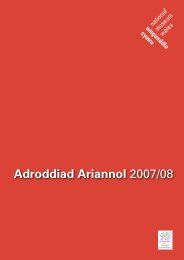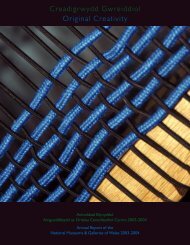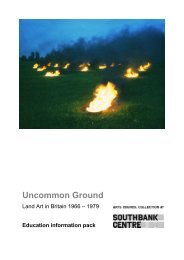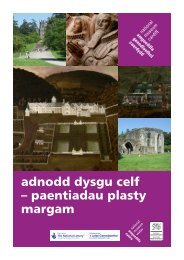Create successful ePaper yourself
Turn your PDF publications into a flip-book with our unique Google optimized e-Paper software.
Y llun<br />
The photograph<br />
Cefais fy ngeni ar 24 Mai 1928 yn 16 Gladys<br />
Street, Coed-elái, tua milltir o’r lofa. Roedd<br />
Coed-elái yn bentref glofaol nodweddiadol, a<br />
dim ond dyrnaid o ffermydd oedd yn yr ardal cyn i’r<br />
pwll cyntaf agor. Ar ôl gadael ysgol, roeddech chi naill<br />
ai’n mynd i weithio ar y rheilffyrdd neu i’r lofa. Ac os<br />
oedd eich tad yn gweithio yn y pwll glo, felly’r oedd<br />
hi i chi hefyd fel arfer. Felly, pan adewais i’r ysgol yn<br />
grwtyn 14 oed ym 1942, dechreuais weithio yng<br />
Nglofa Coedely. Cefais fy magu yng nghanol y<br />
diwydiant. Glöwr oedd fy nhad, a byddwn i a’m<br />
ffrindiau ysgol yn crwydro o amgylch y lofa’n casglu<br />
nytiau a phicied i’r tai weindio a’r adeiladau eraill. Y<br />
diwydiant glo oedd ein byd, ac roeddech chi’n nabod<br />
pawb.<br />
Dechreuais weithio fel gwas colier gyda ’nhad yng<br />
ngwythïen Rhif 3, oedd oddeutu dwy droedfedd tair<br />
modfedd o uchder. Roeddem yn gweithio ar system<br />
pileri a thalcen, gan dyllu hedins (tua phum<br />
troedfedd o led er mwyn gadael lle i basio wrth ochr<br />
y dramiau) a chreu talcenni bob 16 llath ar hyd yr<br />
hedin. Ym mhob talcen wedyn, roedden ni’n cloddio<br />
tua wyth llathen i’r wythïen. Roedd yr hedins tua<br />
saith troedfedd o uchder, gyda’r lle ychwanegol yn<br />
cael ei greu trwy dorri’r garreg o dan y wythïen.<br />
Defnyddiwyd y garreg wedyn i lenwi’r gob. Wrth i ni<br />
lenwi’r gob gyda’r garreg, byddai ’nhad yn taflu’r ‘baw’<br />
ataf i gyda’i raw, ond os oedd yna delpyn mawr<br />
byddai’n gweiddi ‘Bysedd!’ fel rhybudd. Ond os oedd<br />
yn taro’ch llaw chi, byddech yn aml yn dioddef o ‘ewin<br />
du’ a’r unig ffordd o leddfu’r boen oedd ei fyrstio â<br />
phin nodwydd.<br />
Dim ond i symud baw a cherrig yr oedden ni’n<br />
cael defnyddio rhawiau. Doedden ni ddim yn cael eu<br />
defnyddio nhw i symud glo, gan mai dim ond talpiau<br />
mawr oedd eu hangen a byddai’r rhaw yn eu torri’n<br />
ddarnau llai. Roedd gennym ddwy raw, dwy gaib i<br />
dyllu o dan y wythïen (i lacio’r glo) fel y byddai’r<br />
wythïen yn llacio a gollwng, bwyell gyda llafn naw<br />
modfedd, bar rhwygo er mwyn codi’r garreg, gordd<br />
a sbaner neu ddwy. Roedd y colier yn gwneud<br />
popeth, nid dim ond ceibo’r glo yn unig. Roedd yn<br />
fecanig, yn drilio’r tyllau tanio – yn y dyddiau hynny,<br />
doedd dim piston aer i gynnal y dril, roeddech chi’n<br />
gorfod dal y peiriant ar eich ysgwydd. Roedd gennych<br />
gymaint o offer fel nad oedd modd cloi popeth yn<br />
eich bar tŵls felly roeddech chi’n gorfod cuddio<br />
ambell beth!<br />
Byddem yn defnyddio ‘bocsys cwrlo’ i lenwi’r<br />
dramiau â glo. Doedd dim modd cario’r bocs<br />
llwythog gan ei fod mor drwm (tua chanpwys) felly<br />
roedd rhaid i chi ei lusgo neu<br />
ei sleidio i fyny wyth llath i<br />
gyrraedd y dram. Gan ein bod<br />
yn cael ein talu fesul tunnell o<br />
lo, byddem yn ychwanegu hyd<br />
at ddwy droedfedd chwe<br />
modfedd o bentwr uwchben<br />
ymylon y dram (a oedd rhwng<br />
pedair a phum troedfedd o<br />
uchder). Er mwyn rhofio’r<br />
dram, roeddech chi’n gorfod<br />
creu bocs o gnapiau mawr ac<br />
ymestyn drostynt wedyn i<br />
lenwi’r canol â glo llai. Ar ôl<br />
gorffen eu llenwi, roedd y<br />
dramiau hyn yn debyg i longau<br />
bach wrth fynd i lawr y llwybr.<br />
Cefais fy man gwaith fy hun yn<br />
19 oed, ar ôl ‘prentisiaeth pum<br />
mlynedd’. Roeddwn i’n ffodus fy<br />
mod wedi gweithio gyda ’nhad<br />
a’m hewythrod a’m dysgodd sut i ‘ricio’ pren. Roedd<br />
llawer o’r glowyr yn torri’r pren eu hunain oherwydd<br />
gallai gymryd cyhyd i ddysgu’r bechgyn ifanc i’w<br />
wneud yn iawn.<br />
Ni ddaeth baddondai pen pwll i Goed-elái tan<br />
oddeutu 1956, a chyn hynny, roeddwn i’n gorfod<br />
cerdded adref yn fy nillad brwnt. Byddai’r fest yn<br />
diferu o chwys erbyn i mi orffen gweithio, felly<br />
roeddwn i’n ei thynnu i ffwrdd a’i gadael yn fy nhun<br />
bwyd cyn cyrraedd y prif lwybr lle’r oedd yr aer fel<br />
rhew. Byddai’r fest yn cael ei golchi bob dydd, tra câi’r<br />
dillad eraill eu hongian o flaen y tân ar ddiwedd<br />
diwrnod gwaith a’u golchi bob dydd Gwener yn unig.<br />
A sôn am waith golchi! Roedd angen berwi bwcedi o<br />
ddŵr ar y tân ar gyfer ymolchi, a llenwi boeler o ddŵr<br />
i wneud y golch. Roedd ambell ewythr yn gwrthod<br />
sgwrio’i gefn tan ddiwedd yr wythnos, rhag i hynny<br />
eu gwanhau yn eu tyb nhw. Ni fyddai rhai o’r dynion<br />
yn cael bath tan y bore, ar ôl cwympo i gysgu’n sownd<br />
ar ôl swper.<br />
Un diwrnod, ym 1950, roeddwn i’n dychwelyd o’r<br />
gwaith tua 3 o’r gloch gydag Oswald Watkins (tua 57<br />
oed) a William Griffiths (tua 34 oed) pan welon ni foi<br />
yn pwyso yn erbyn giatiau’r groesfan rheilffordd.<br />
Dywedodd ei fod yn gweithio i gylchgrawn Life a’i fod<br />
yma ym Mhrydain i bortreadu’r etholiad cyffredinol.<br />
Gofynnodd am ganiatâd i dynnu lluniau ohonom ni.<br />
Tynnodd rhyw bedwar llun ar ôl ein trefnu i sefyll<br />
gyda’n gilydd, a phentref Coed-elái yn y cefndir.<br />
Dwi’n credu fod ganddo syniad yn ei ben yn barod,<br />
Vernon Harding © W. Eugene Smith/Magnum Photos<br />
Iwas born on the 24th of May 1928 in 16 Gladys<br />
Street, Coedely, about a quarter of a mile from<br />
Coedely Colliery. Coedely was a typical Welsh<br />
mining village, before the colliery was sunk there were<br />
only a few farms in the area. When you le school you<br />
either went on the railways or into the colliery. If your<br />
father worked at the pit you usually ended up there as<br />
well. So, when I le school in 1942 at fourteen years<br />
old, I started in Coedely Colliery. I was brought up<br />
amongst the coal industry. My father was a miner and<br />
my school friends and I used to wander around the<br />
colliery picking nuts and go into the winding houses<br />
and other buildings. Mining was a very familiar thing<br />
to us, it was a mining community and you knew<br />
everybody.<br />
I started work as a collier’s boy with my father in<br />
No.3 seam which was about two foot three in height.<br />
We were working on the pillar and stall system,<br />
driving headings (about five feet wide to leave passing<br />
room at the side of the drams) and turning stalls every<br />
sixteen yards along the heading. e stalls were then<br />
worked about eight yards into the seam. e headings<br />
were about seven feet in height, the extra room being<br />
cut from the stone beneath the seam. e stone was<br />
then used to pack the gob. When we were packing the<br />
gob with stone my father would be throwing the<br />
‘muck’ to me with his shovel, if he threw a large lump<br />
he would shout “Fingers!” as a warning but if it caught<br />
your hand you’d oen end up with a ‘black nail’ which<br />
you had to puncture with a needle to relieve the pain.<br />
We were only allowed to use shovels when shiing<br />
stone and muck, we weren’t allowed to use them for<br />
moving coal as only lump coal was needed and<br />
shovelling them broke the large lumps up. We had two<br />
shovels, two coal picks for holing under the coal seam<br />
(to ‘work the coal’) so that the seam would loosen and<br />
drop, a hatchet with a nine inch wide blade, a ripping<br />
bar for levering out stone, a sledge and a couple of<br />
spanners. e collier did everything, he didn’t just<br />
pick at the coal, he was a mechanic, he drilled the shot<br />
holes – in those days you didn’t have an air leg to<br />
support the drill, you had to hold the machine on<br />
your shoulder. You had so much equipment that you<br />
couldn’t lock it all on your tool bar so you had to hide<br />
some of the stuff!<br />
We used to have to use ‘curling boxes’ to fill the<br />
coal into the drams. You couldn’t carry the loaded box<br />
because it was so heavy (about one hundredweight) so<br />
you had to drag or slide it up to eight yards to reach<br />
the dram. We were paid by the tonnage of coal we<br />
produced so we used to ‘race’ the coal about two feet<br />
six above the rim of the dram (which was between four<br />
and five feet in height itself). To race a dram you had<br />
to build a box of large lumps and reach over these to<br />
fill the middle with smaller ones. When they were<br />
being taken out, the raced drams looked just like little<br />
ships going down the roadway. I got my own working<br />
place at 19 aer my ‘5 years apprenticeship’. I was lucky<br />
as I had worked with my father and uncles who had<br />
taught me to ‘notch’ timber. Training a boy to cut the<br />
timber properly was time consuming so most colliers<br />
did it themselves rather than teach their boys to do it.<br />
e pithead baths came to Coedely around 1956,<br />
up till then we had to walk home in dirty clothes. My<br />
vest would be wringing wet with sweat when I<br />
finished work so I would take it off and stick it in my<br />
tommy box before I reached the main roadway where<br />
the air was freezing. My vest was washed every day<br />
but the rest of my clothes where hung in front of the<br />
fire when I got home and only washed on a Friday.<br />
Washing was a big business; buckets of water had to<br />
be boiled on the fire for bathing and a boiler of water<br />
for the clothes. Some of my uncles wouldn’t wash their<br />
backs until the end of the week because they reckoned<br />
that it would weaken them. Some men would have<br />
their dinner first then fall asleep and wouldn’t bath<br />
until morning.<br />
One day, in 1950, I was coming from work about 3<br />
o’ clock with Oswald Watkins (about 57 years old) and<br />
William Griffiths (about 34 years old) and there was a<br />
chap leaning on the railway crossing gates. He said that<br />
he was working for Life magazine and was in Britain<br />
10 11





